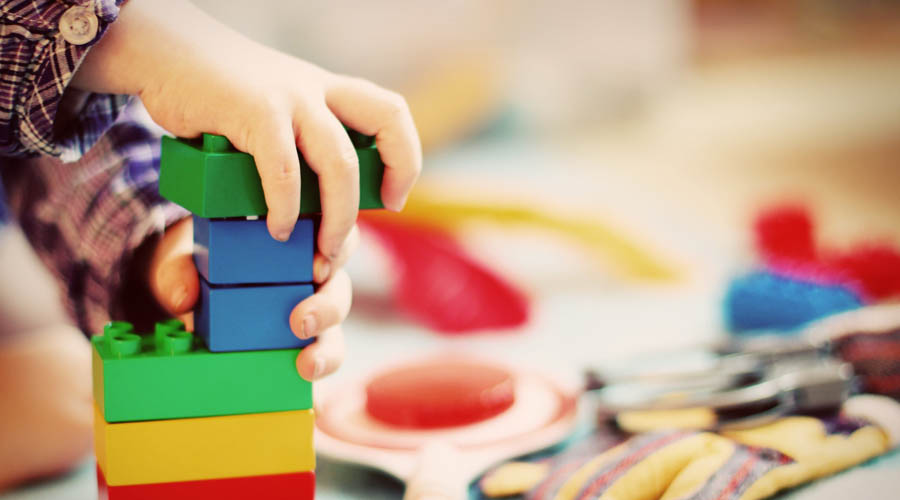Sensorimotor Early Activities for Children with ASD
By: Mrs. Rohini Yogesh Wagh
Autism is a developmental disorder that emerges in the first three years of child and it effects the child’s social interaction, communication and behavior. Some autistic children remain engage in flapping their fingers and hands, rocking, spinning the objects or toy. These actions appear to have no meaning but they stimulate themselves. Sensory and motor abnormalities commonly found in autism kids. So early intervention of these kids is very important before the age of three every medical professional must have the knowledge of this problems. If awareness about this is made then we can also give effective result to these autism kids and definitely there will a change in their life. So implementing the right solution is the path of success for this kids. There is need to understand the sensory motor development in early stage. As we all know sensory integration treatment is used for children with autism as well as hyperactive and premature born kids and C.P.
Sensory motor disorder has been described in following ways, as the perception of sound, vision, touch, taste and smell as well as kinesthetic and proprioceptive sensations. It can be hypo or hyper responsiveness to sensory input. Sensory motor development and functional skills development vocational skills, social interaction skills. Young children typically use their motor skills to explore their environment and these activities develops the basic academic skills in children.
Sensorimotor deficiency is the inability sufficiently perceive brain senses. Sensorimotor deficiency is not considered as brain damage. J.Ayres named this condition as “brain dyspecia”. (Royeen and Lane 1991). Some cases when this sensory motor disorder is severe, the child may suffer from mental defects. We may speak of four neurological disorder mechanism is considered to be related to autism in children with SPD. The child may have difficulty in focusing on a specific point because the brain has difficulty in responding to too much or too little sensory information. The hypersensitivity and protesting negative dissocial behavior. The child may easily get distracted by perceiving all the stimulant in the environment. Change in daily routine, crowd and noise are likely causes of anxiety and in hyposensitivity the child needs more stimulant even to develop simple skills. Hyposensitive child is prone to touching and feeling.
Tactile sense-
A child may be so over sensitive that he/she might not cry even if they get a shot of injection. Tactile sense is a necessary skill in daily life which ensures protection for the danger and to know the difference between the different objects. The child begin to recognize the world by feeling the warm touch of mother. Movement and touching are the first teacher for a child. If the child is having problem in tactile sense it may not be possible for them to learn through touching. Most of these problems affect the child’s academic success and language development. Tactile sensory allow the child to subconsciously realize their body parts and their interaction with each other. By developing body awareness, the child will know what the situation is about as well as what he/she do about it. If it affects the child will undergo various difficulties e.g. – the child may have difficulties directing limbs when getting dressed.
- The child may feel the gymnastic ladder through hands and feet and may successfully climb it.
Child with tactile disorder may develop gross motor skills late. Children will also face difficulties in handling simple tools as a scissors, paint brush, fork and spoon. They also have difficulty in ADL skills. They also don’t want to use their tongue and lips to articulate so they have no linguistic skills hence they tend to use sign rather than words. These children may be scared by soft touches while showing no reaction to painful situation. Some autism children doesn’t like the self-care activities such as haircut, washing face, nail clipping along with wearing clothes.
Tactile sensorimotor activities for kids-
- Encourage kids to play with or touch the bread paste, pudding, fresh fruits and vegetables bowl.
- Walking on different material such as sand, rope, artificial grass, plastic, carpet.
- Give the child a hard or soft touch of metal, glass, wood, plastic toys and objects.
- Sand activities- draw shapes or lines on sand surface. Find out small toys hidden in sand.
- Plastic bottle with hold, cold, warm temperature to improve the touching behavior.
- Give large empty bowls and small cup and smaller bowls filled with water. Encourage them to pour the water from one bowl to the other.
- Give the child different color play dough and teach them to make a ball or different shapes.
- Rolling on different surfaces.
- Roll in the baby in different cloth texture blanket, silk sari, cotton bed sheet, woolen shawl and encourage them to play with soft toys.
- Sandwich pressure with ball or pillow.
- Playing with blowing toys.
- Allow them to do things by their own – eating, brushing.
- Parents should hug and kiss their kids. Massage them with body powder, baby lotion and aroma oils and observe the response of the kid.
- Recognition of body parts. Jumping, walk on hands, hand stamping activities, playing with shave foam, drinking juice with straw.
Visual-
Children with autism do not pay attention to speech. Some autistic individual experience severe visual disorders, some may have disharmony and color separation disorder. Some also have difficulties in spotting objects with darker colors. Although children with autism do not look at human face and many objects in their environment it is known that they might see the moving fan, rotating and shiny objects for long time. Visual problems in autism child manifest as weak eye contact, sideway looking, blinking and light irritability. Visual closure is often considered to be a function of visual discrimination. This is the ability to identify or recognize a symbol or object when the entire object is not visible. Difficulties in visual closure can be seen in such school activities as when the young child is asked to identify, or complete a drawing of, a human face. This difficulty can be so extreme that even a single missing facial feature could render unrecognizable by the child.
Visual sensorimotor activities –
- Catch and throw ball activity.
- Tell them to pour any juice or color water in the glass.
- Play with jigsaw puzzle and blocks to build structure.
- Coloring simple pictures.
- Sensory bottles , sensory toys, toys with different color lights
- Beading different color and shapes.
- Sorting the color and shapes.
- Paper cutting with scissors.
- Candle activity.
Auditory –
Autism is sometimes described as a social/ communication problem. Processing auditory information is a critical component of social communication and people with autism spectrum disorders typically have problems processing this information. One problem occurs when a child hears speech sounds but does not perceive the meaning of the sounds. Autistic children may show complex reaction to sound while showing no reaction to some sounds and their parents to believe that the child have hearing impairment. In some cases child may not react to his/ her own name. it was also found that autistic children cannot separate sounds in noisy environments and are disturbed by it.
Auditory sensorimotor activities-
- Toys or activities that makes sound.
- Movement activities with toys.
- Animals, birds, transport sound.
- If the child is hyper or shows signs of anxiety then play calm music.
- Listen to Vedic mantras with kids it has good effect due to its sound vibrations.
- Water drop sounds.
- Make babbling sound and encourage the kid to imitate that sound, by this activity baby can give eye contact to parents and relatives.
- Give small commands to do an action.
Vestibular sense-
It is related with joints, eyes and body concerning movements and balance. If vestibular sense is disturbed then brain can’t receive the sensory signal by central nervous system. So autism kids have a problem to walk on heightened levels. These children may not develop postural response and may never crawl or maybe delayed from learning to walk. They often fall down when they walking will hit the furniture and collapse when moving vestibular disorder may also cause difficulty in understand a language. The movement is not fun for a child. The child may be nervous or angry and may avoid moving, may refuse to ride a bike or play with side.
Vestibular sensorimotor activities-
- Crawling or hopping on swiss ball, tossing on bean bag.
- Physical obstacle activity.
- Animal walk- frog walk, crab walk, duck walk, monkey walk.
- Jumping from high places. (from a table or a bench)
- Catching a ball with both hands.
- Climbing ladder.
- Walking in a straight line and standing on one foot.
- Dancing and making actions on songs.
- Jumping on a trampoline.
- Swimming, cycling.
- Standing on a table doing various activities such as clapping, stomping, and tipping on the table. Use reinforcement by giving the favorite food to the child.
Proprioceptive sense-
It provides information about the movements and the body position. It controls our body movements with joints and muscles. This is required skills like catching or throwing a ball and ladder climbing. Proprioceptive sense contributes to body awareness motor planning and motor control of body parts. It enables abilities like straight walking, sprinting, ladder climbing, carrying a luggage, sitting, standing and leaning upside down. It also assists to feel emotionally safe. Disorder in this sense may create the coordination difficulty in the children. Child may have problem in switching from one action to another. It affects the child’s self-confidence and self-awareness.
Proprioceptive sensorimotor activities-
- Walking with wheel barrow.
- Rope skipping and weight lifting.
- Walking with holding ball.
- Use color adhesive tape and make a zigzag line or a circle and instruct the child to walk on it.
- Buttoning, zipping, shoe lacing, pulling and pushing.
- Ladder climbing and sprinting.
- Sitting and playing on the swing.
- Jumping on trampoline.
- Crawling through the tunnel games.
- Catching or throwing a ball.
- Walking in a straight line, carrying luggage and sitting straight on the chair.
If the milestones are not achieved and there is no sensorimotor development in the child, then pediatric and psychologist asses the kid and therapist conduct the sensory profile and after making an activity plan therapy activity starts. In most of the cases early intervention plays an important role. The kids achieve the best result.
The treatment approach for children with sensory motor processing or disorders is to use fun in everyday activities and games which are motivating for the child. The game becomes more interactive as the child begins to challenge himself and starts working toward the higher levels of sensorimotor development and functional skills. Through an evaluation process and parents’ feedback, the therapist identifies the child’s processing abilities, arousal level, sensitivities to sensory input and behavior. Sensorimotor activities develop gross motor skills, organizational skills, social skills and improved behavioral responses.


Very nice information…..